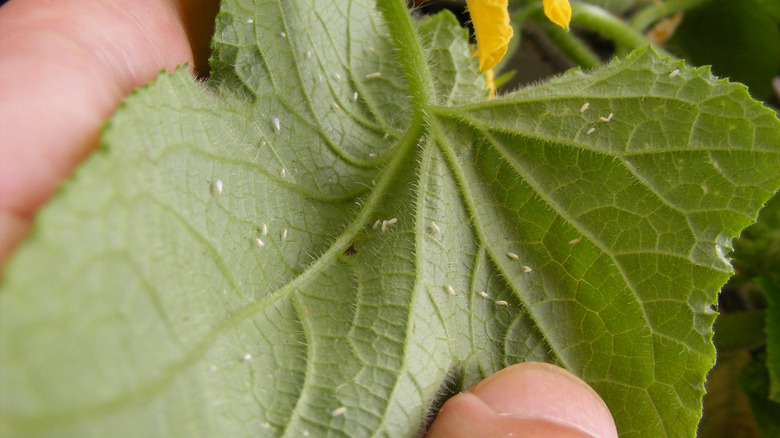Popular Crops That'll Attract Whiteflies To Your Garden (& What To Do About It)
Home-grown crops are delicious, nutritious, and often easy to grow. However, like any plants, they are also susceptible to garden pests that wreak havoc. Whiteflies are notorious for infesting plants and spreading disease. Popular crops like tomatoes, beans, and lettuce attract whiteflies, which, in turn, damage the garden. When the flies get out of control, they cause premature leaf drop, illness, poor health, and plant death. As a gardener, it's critical to stay on top of your crops to prevent large-scale infestations, and that includes knowing which plants are more tempting to the pesky whitefly.
Whiteflies don't simply eat the vegetables and fruits; they suck the tissue from stems and leaves. The damage they cause can lead to yellowing leaves that are dry and distorted. Heavy infestation will weaken plants and stunt their growth despite the species' short lifespan. Additionally, many whitefly species carry diseases they can pass on to your otherwise healthy plants. These diseases range from semi-persistent to persistent. And, with their resistance to many insecticides, they may prove challenging to thwart. Luckily, some natural interventions have proven successful.
What crops are most susceptible to whiteflies?
Unfortunately, whiteflies infest many of our favorite crops. Most commonly, they target fruits like cucumbers and eggplants. However, there are multiple species of whiteflies, and they all have preferences. For example, ash and citrus whiteflies typically infest broadleaved trees and shrubs like citrus, pomegranates, and pear trees. Sweet potato whiteflies, as their name would suggest, love to dine on sweet potato leaves and stems. They don't stop at a certain type of crop, either. Fruits are popular, but starchy vegetables and gourds are also on the whitefly menu. Even leafy greens like cabbage and lettuce are not safe from the sap-sucking insects.
Tomatoes, squash, and cucurbits not only attract these pests, but they're also susceptible to a host of very specific viruses. Viruses like the tomato yellow leaf curl virus are considered persistent and circulative, meaning unless they're treated, they will ravage the plant and likely spread to nearby crops. It's important to intervene after the first exposure so that remaining whiteflies without the virus will not pick it up and spread it around your garden.
How to get rid of whiteflies
A few whiteflies may not be anything to worry about, but it's important to recognize an infestation. Once you identify the problem, it'll be much easier to solve. First, check the leaves and stems of your crops. Whiteflies congregate there to feed; you may also find eggs on the underside of the leaves. Should no flies be present, examine the condition of the plant. An infestation could be present if the plant is wilting or the leaves are yellowed. Another telltale sign is a black fungus called sooty mold left behind by whitefly secretions.
Should you find that you are having issues with whiteflies and not another garden pest, start small. Yellow sticky traps keep flies away from crops and prevent the pests from going from plant to plant. A more advanced solution involves releasing natural predators like Encarsia formosa, a parasitic wasp considered a good bug for pest control. These predators can drastically lower your whitefly population and have been sold commercially for that sole purpose. If the infestation is unresponsive to these interventions, it might be time to call a professional. Because whiteflies are resistant to many pesticides, attempting to tackle a large infestation on your own could prove very challenging.



